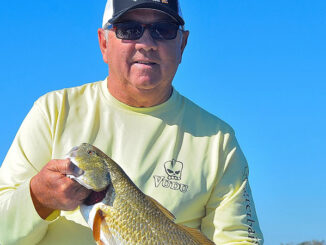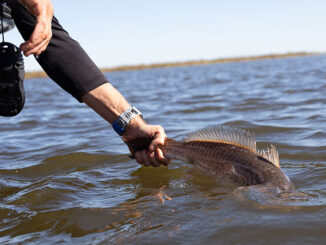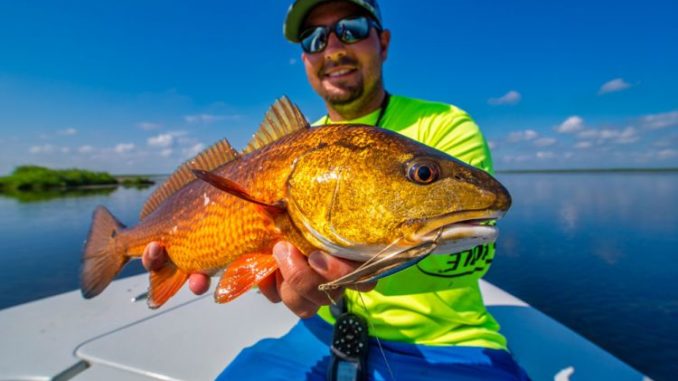
September is when coastal fishing turns on its head, with redfish moving out and trout moving in. Here’s how one guide ensures he’s in position to intersect the two species.
The water was a sheet of glass when Capt. Austin Plaisance wheeled his Blazer Bay out of the canal into the shallow, grass-filled pocket.
And it was quickly apparent redfish were swarming the cove.
“Look at all the wakes,” Plaisance called out.
Indeed, the open water between grass beds looked like a fleet of submarines was on the move.
“There’s a big school of fish in here,” Plaisance said as he pulled the boat off plane.
The fact that he had spooked every redfish in the vicinity didn’t faze the owner of Louisiana Redfish Outfitters.
“They’ll settle down and come right back,” Plaisance predicted.
He and YouTube’s Todd “Marsh Man” Masson began working swimbaits through the grass. I chose a ChatterBait.
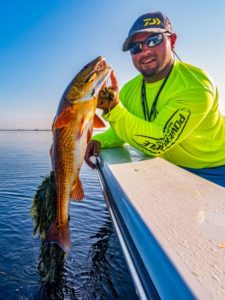
I was the first to get a bite, a hard whack that knocked my lure sideways. But somehow, the fish missed the hook.
More bites were in the offing, and Masson and I soon had chunky marsh bass flopping over the gunnel.
But the redfish for which we were hunting seemed to have disappeared.
Until Plaisance switched to a spoon — one my least-favorite baits in existence.
Several casts later, he sank the hook into something that didn’t budge.
“That’s a redfish,” he grunted.
And it wasn’t a little boy. The fish didn’t like the hook in its mouth a bit, stripping drag off the reel.
The Duce spinning rod doubled, but held tight.
Moments later the redfish was boatside, and Plaisance was digging through a ball of milfoil to get his hands on the prize.
The red he pulled over the gunnel was a glowing bronze color, thanks to the crystal-clear water.
We took photos, Masson tagged the fish and we released it to fight another day.
That was all the prodding Masson and I needed to switch lures. He went with a standard Johnson spoon, while I chose a Bomber Who Dat.
We were soon wrestling our own reds to the boat.
Stick and move
Plaisance was correct when he said the fish would settle and start feeding again. He simply put his trolling motor down and fished the area until the reds returned.
Of course, a bull red on the end of an angler’s line causes enough commotion to spook its friends. But Plaisance didn’t even let that worry him.
If redfish stopped waking near the boat, he would simply crank his outboard and idle to the next active area.
Redfish would scatter, but a few moments later we would pick up more.
It’s the kind of action that can be expected this time of year, when redfish are beginning their move outside.
Success is just a matter of getting in position to intercept them.
Presence of pogies
“Fish start moving to areas like American Bay,” he said.
So if redfish are on your agenda, you can just hit those bays on the edges of the Delacroix marsh. In addition to American Bay, Bay Lafourche, Gardene and Lake Camp fill with reds heading out of the marshes.
“We’re fishing in the bays themselves,” Plaisance said. “Fish the islands out in the middle.”
He said vegetation is not as much of a factor as during the height of the summer when fishing interior areas.
“It’s a lot less congested with grass down there,” Plaisance said.
But the fish are still there because that’s where the groceries have moved.
“I’m looking for bait,” Plaisance said. “They’re keying in on pogies this time of year — especially the big fish.
“The pogies are the giveaway.”
Again, vegetation is not as prominent in these outer bays, but that doesn’t mean he’s just fishing wide-open water.
“You’re going to be fishing the flats,” Plaisance explained. “We’ll be looking for hard current points — something where the water temperature will be a little less.”
And water temp is a real key: Even though cool fronts often push through in early September, cool-downs don’t last long enough to drop water temperatures.
“It’s usually late September before we see the weather really cooling down,” Plaisance said.
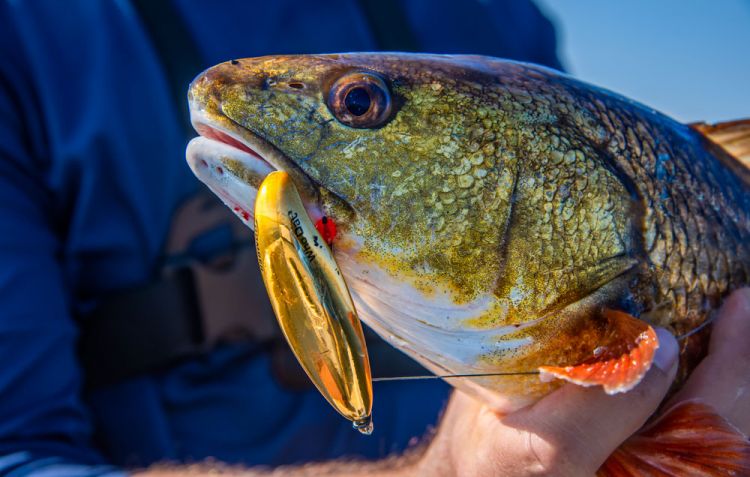
And if he does spot a bit of grass, the guide makes sure he spends some time around it.
“Any time you find grass, you’ll have a current break,” Plaisance said. “Where it hits that grass bed, you’ll usually find fish on it.”
Dead-on with dead shrimp
Artificial baits are still in play, with spoons and paddletail swimbaits being best.
But Plaisance said he grudgingly begins using that guaranteed redfish-producer: dead shrimp.
The key to success with stink crickets isn’t a magic formula.
“We are usually in about 4 feet of water, so we have the shrimp on a jighead about 18 inches under the cork,” Plaisance said.
Then it’s just a matter of throwing the rig out and soaking the bait, with a few loud pops of the cork to attract prowling reds’ attention.
One of his other keys is leader size. Plaisance always uses fluorocarbon below his corks, with 15- to 20-pound being his go-to.
If he’s seeing fish on a flat but not getting bit, even using dead shrimp, it’s time to make a change.
“I will go lighter on my leaders if I need to,” Plaisance said. “It makes a real difference.”
